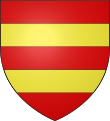Archibald Cameron of Lochiel
Archibald Cameron of Lochiel (1707–7 June 1753) was a doctor and a prominent leader in the Jacobite rising of 1745. On 7 June 1753, at Tower Hill, he was the last Jacobite to be executed for high treason.
.jpg)

Before the uprising
Archibald Cameron was born in 1707, the sixth child (and third surviving son) of Isabel (née Campbell) and John Cameron, the 18th Lochiel.[1]
Cameron's father, The Lochiel, had participated in the failed 1715 Jacobite rising and, as a result, had become an exile, living first in Paris and then Boulogne, and not returning to Scotland until November 1745. Archibald Cameron's elder brother was Donald Cameron of Lochiel, who was the Clan Cameron chief in the absence of their father, and is known in Jacobite history as "The Gentle Lochiel".
Archibald Cameron initially attended the University of Glasgow to study law, before transferring to study medicine at University of Edinburgh. He completed further studies at the Sorbonne in Paris and the University of Leiden in the Netherlands. He subsequently returned to the Scottish Highlands, married his Lochaber cousin, Jean Cameron,[2] and fathered seven children.[3]
1745 uprising
When Charles Edward Stuart ("Bonnie Prince Charlie") first arrived in Scotland Cameron was despatched by his brother to Loch nan Uamh to communicate the futility of the enterprise and persuade the Prince to return to France.[4] However, Prince Charles persuaded Cameron otherwise and soon the Camerons joined him in armed revolt.
Archibald Cameron first saw action in late August 1745, when he helped to lead a fairly futile attack on Ruthven Barracks.[5] In the campaign that followed Cameron seems to have been promoted to the rank of lieutenant colonel in his brother's clan regiment.[6] The Newgate Calendar's hagiography portrays him as being a pacifist by nature, refusing to offer more than his surgical skills in the cause, but this is likely to be inaccurate[7] since Cameron was slightly wounded in action at the Battle of Falkirk in January 1746.[8] He is also recorded as having performed surgery on his brother after he suffered two broken ankles and other injuries at the Battle of Culloden.
The defeat at Culloden ended the Jacobites' hopes, and both Cameron brothers, along with their father, became fugitives from government troops. After the burning of the family seat, Achnacarry House, the Cameron family hid at Badenoch. However, despite the danger, the Prince was determined to meet The Lochiel. Archibald Cameron was sent to Loch Arkaig to escort the Prince to the family's hiding place (3 September). The whole party then moved to Ben Alder, the seat of Ewen MacPherson of Cluny, keeper of the Loch Arkaig treasure. At Ben Alder Castle on 13 September 1746 word came that French naval ships were waiting at Loch nan Uamh, and on these the whole party escaped to France on 19 September.
Betrayal and execution
In exile Cameron remained in Prince Charles's service, travelling with him to Madrid in 1748 and returning to Scotland privately in 1749. In 1753 he was sent back to Scotland again to obtain money from Loch Arkaig[9] and to participate in a desperate plot to assassinate George II and other members of the British royal family. However, while he was staying secretly at Brenachyle by Loch Katrine, he was betrayed by MacDonell of Glengarry, the notorious "Pickle the spy", and members of his own clan who by this time were sickened by his Jacobitism.[5] He was arrested and attainted of high treason under the Attainder of Earl of Kellie and Others Act 1746 (19 Geo. 2, c. 26) for his part in the 1745 uprising. He was imprisoned in Edinburgh Castle then taken to Tower Hill in London.[10]
On 7 June 1753 Cameron was drawn on a sledge to Tyburn and hanged for 20 minutes before being cut down and beheaded. His remains were buried in the Savoy Chapel, Westminster.[11] He was the last Jacobite to receive the death penalty. In his final papers, written from prison, he still protested his undying loyalty to the Jacobite cause and his episcopalian principles.[12]
In 1753 John Cameron of Dochanassie composed "A Song to Doctor Cameron", a song in Gaelic in commemoration of Cameron's life.[13]
Cameron is a leading character in D. K. Broster's novel The Gleam in the North (1927 ), the second in her Jacobite trilogy.
References
- Clan Cameron Genealogies.
- fionamsinclair.co.uk Archived 12 September 2015 at the Wayback Machine
- The Newgate Calendar (1824): Account of Cameron's execution.
- Kybett, Susan Maclean (1988). Bonnie Prince Charlie: A Biography. London: Unwin Hyman. p. 122. ISBN 0044402139.
- Kybett, Susan Maclean (1988). Bonnie Prince Charlie: A Biography. London: Unwin Hyman. p. 128. ISBN 0044402139.
- Clan Cameron Archives Account of the Battle
- exclassics.com
- Account from the Clan Cameron Archive
- Kybett, Susan Maclean (1988). Bonnie Prince Charlie: A Biography. London: Unwin Hyman. p. 268. ISBN 0044402139.
- The Peerage website.
- The history of Clan Cameron
- "Letters Written in the Tower of London 5-6 June 1753", Clan Cameron archives
- "A Song to Doctor Cameron", Clan Cameron archives.
Sources
- Profile on Am Baile website.
- Kybett, Susan Maclean Bonnie Prince Charlie: A Biography, London: Unwin Hyman, 1988. ISBN 0044402139.
- Mackenzie, B. W. (Lord Amulree) "Dr. Archibald Cameron", Medical History, July 1971; 15(3), pp. 230–240.
- Scott, Sir Walter, Redgauntlet, 1824: relevant original documents can be seen at the Clan Cameron Archive